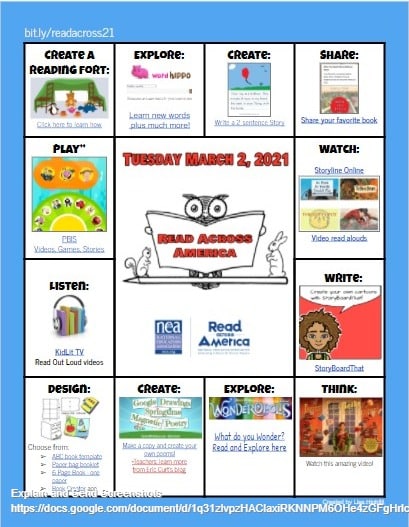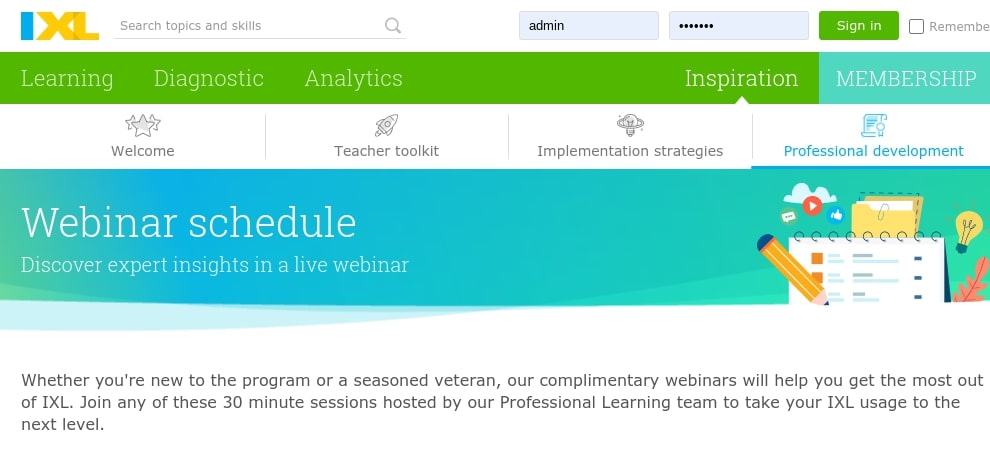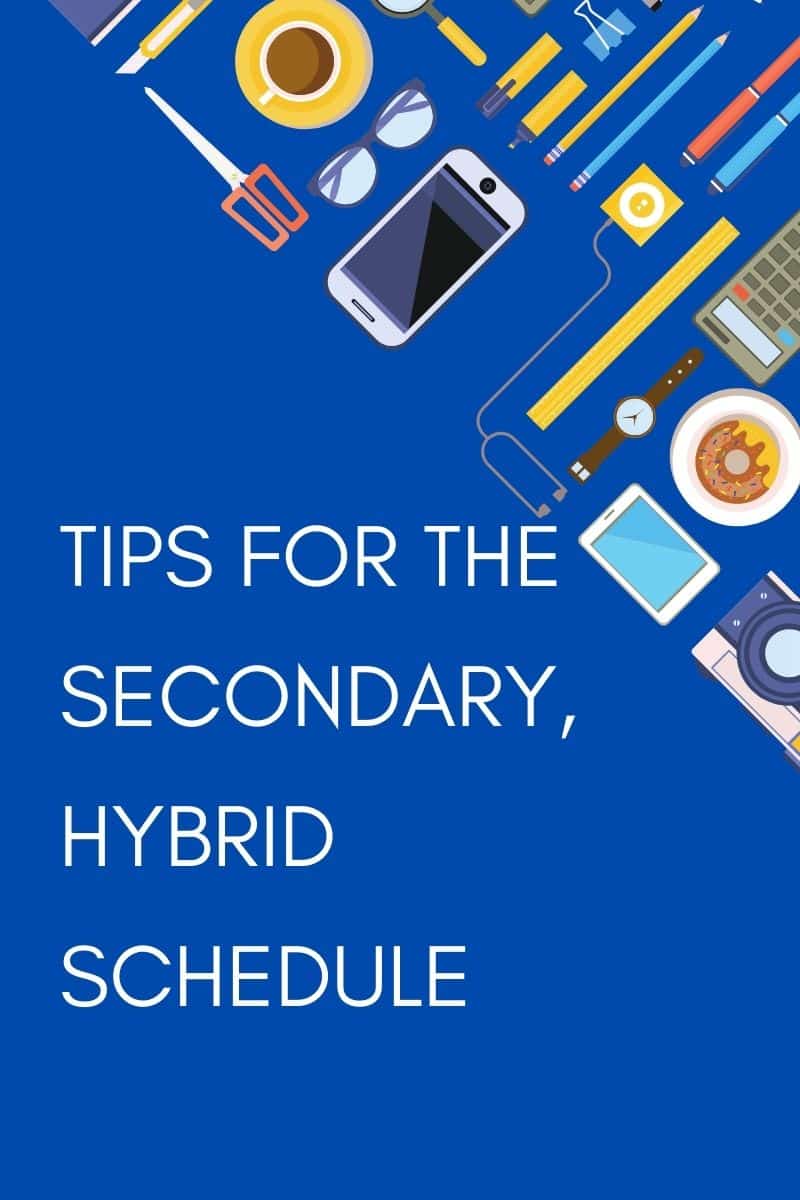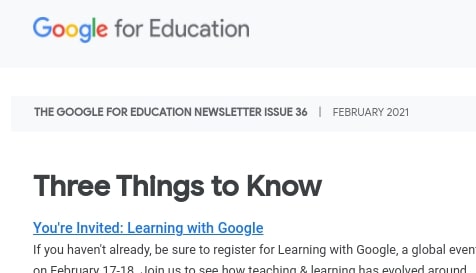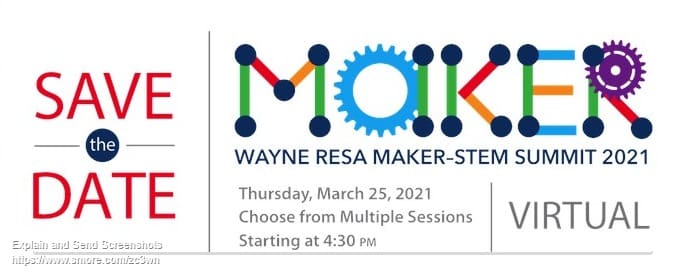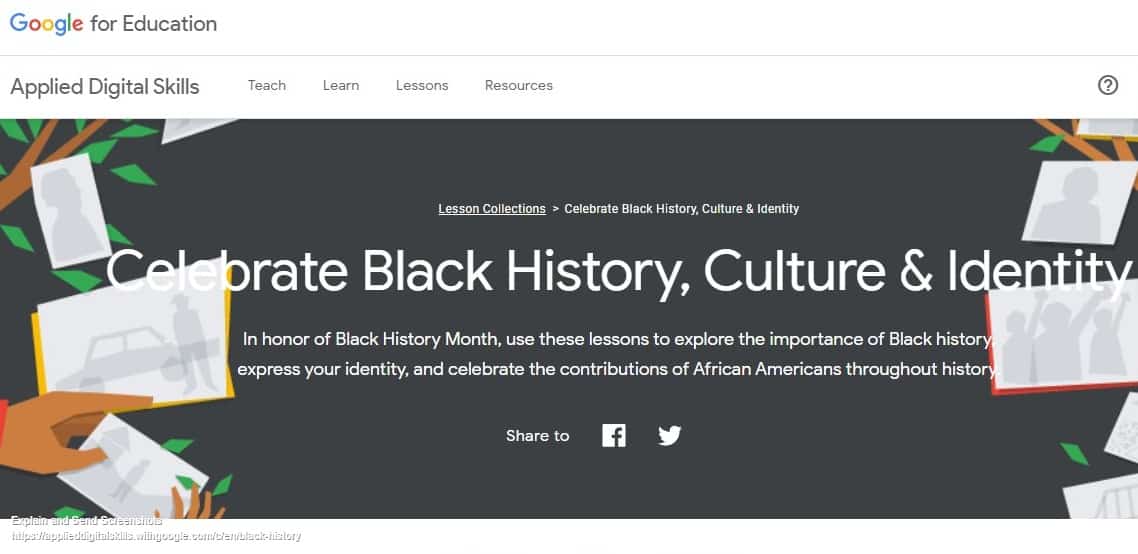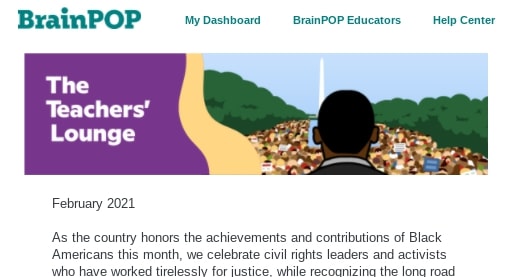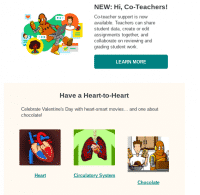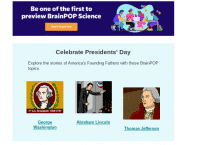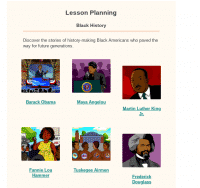March is Reading Month. To celebrate, use this “activity board” for students to explore books and create their own literary works. Be sure to preview the links yourself and File/Make a Copy if you want to make modifications. You’ll need to review the “Create a Reading Fort” link to insert your own place where students can share what they create, perhaps they could post a picture to the Canvas discussion board. You can also share this particular resource with the short link: bit.ly/readacross21 Happy Reading Month!
MISTAR-Q Announcement: New Login Screen Coming Soon
For all staff who use MISTAR-Q you will soon see a new login screen with an updated styling and logo. NOTE: A user’s credentials WILL NOT CHANGE with the new login screen.
New login screen with District Announcement sample.

Once a user logs in, there are more selections if more than one track is available to the staff:

The user can select the radio button of Current Year tracks or All tracks. This is a very helpful feature for those staff, like secretaries and counselors, who have tracks open in both the current and next year.
IXL professional learning opportunities to fit your schedule
Whether you’re new to the IXL program or a seasoned veteran, their complimentary webinars will help you get the most out of IXL. Join any of these free 30 minute sessions hosted by their Professional Learning team to take your IXL usage to the next level.
A few webinar topics are listed below.
- Standards-based instruction with IXL
- Take your classroom online with IXL
- Best Practices for hybrid models
- Science and social studies strategies
- Quickly assess students’ levels with IXL’s Real-Time Diagnostic
- Uncovering insights in IXL Analytics
To attend one or more of their free 30-minute sessions, teachers and administrators can sign up here.
Some links to check out and upcoming Google updates
John Sowash’s monthly EDU newsletter always lists ten or more links he briefly describes and commends for educators to check out. Some recent ones he’s called out are:
- Virtual games from Arts & Culture – “Play with Arts & Culture” – a collection of interactive games that make art, culture and history accessible in a fun and educational way. In one, challenge your students to complete a virtual jigsaw puzzle. It’s fun and the whole class can participate!
- Panopto screen recording – this free screencasting tool offers some unique features like the ability to record from multiple cameras and replace your background.
- Dino QR codes – The Chrome browser now has a built-in QR code creator with a cute dino included! No need for a Chrome extension, just click the URL bar and look for the QR code symbol! Jeremy Badiner created a great guide as well.
- Get to know the student behind the mask – this is a really nice blog post by 5th grade math teacher Becky Thal expressing the importance of connecting with students on a personal level.
- Mindset Moment with Andrew J. Canlé – these quick videos communicate positive ideas in a short, entertaining format that are perfect for discussion questions or brain breaks.
- Link Lock – password protect any link with this free, simple web utility.
On February 17th Google announced several updates for Google Workspace for Education. John’s newsletter has organized some of them into infographics shown below.
FOR CHROMEBOOKS….
The screen recording updates are very exciting, encouraging students to press record for formative and summative assessments which can be very powerful and now more easily done on a Chromebook! Stay tuned to see if this will also allow students to record their screen via Canvas Studio.
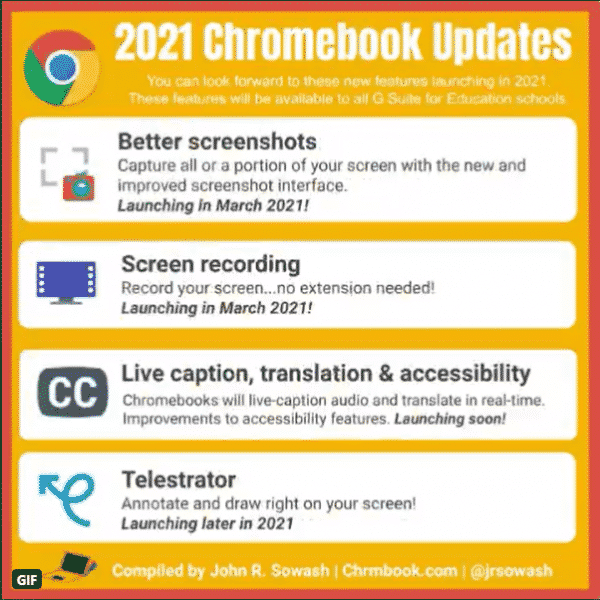
FOR GOOGLE DRIVE….
There are also several updates apparently coming soon to Google Drive. The two that will most likely impact students and teachers are Form draft responses and revision history in Jamboard. In Google Forms, students will be able to stop and return to a form at a later date and time. Please note this is set to launch, “later in 2021” so do not plan to utilize this functionality just yet. One of the biggest frustrations with Jamboard has been the fact that frames can be easily removed and those changes are very difficult to track. Soon, it will be much easier to track changes and revert to previous versions in Jamboard.
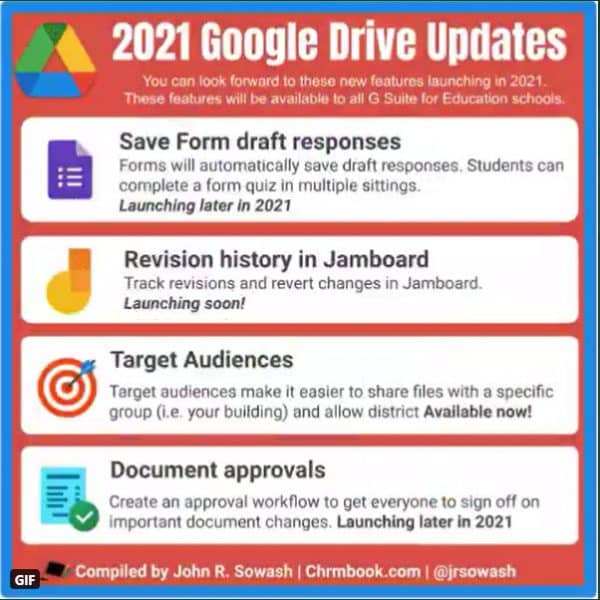
Tips for the Secondary, Hybrid Schedule
Now that P-CCS is bringing middle school and high school students back on-campus, teachers may wish to further adjust their instruction for optimized learning with the new schedule. The hybrid schedule feels very unique to the times we are living in. Fortunately, schools across the country have been using it and teachers have insights to share. For this post, I have borrowed mostly from the work of Jennifer Gonzalez (Cult of Pedagogy) and Catlin Tucker, an experienced, blended learning coach. Consider reading the original posts for more information.
Four Models:
- Station Rotation: Think of your week or class period in 3 kinds of “stations” for students to rotate through: teacher-led, online activity, and an offline activity. Here’s a great template from Stephanie DeMichele. Here’s a link to some specific ideas for core content areas.
- Flipped Learning: Move the act of direct instruction to asynchronous video so it can be more accessible for all (pause, re-watch, captions). Think of your week or class period in terms of a pre-video activity, during-the-video activity, and a post-video activity. If you desire, save time, by recording snippets of intended instruction during your live class to post in Canvas, directions here.
- Playlist/Hyperdoc Model: Playlists allow students to move through a sequence of learning activities. The playlist can build in choice as far as what modality and what combination of activities students choose. This model is also very similar to a hyperdoc which guides students through a complete lesson flow. In this model, teachers design the lesson in-advance and then spend time in class connecting with individuals and small groups to answer questions, clear misconceptions, and provide feedback.
- Pre/In/Post Class: This model simply helps you think about planning in terms of synchronous and asynchronous. Utilize Sections in Canvas to divide your class into cohorts so that each one sees their work at the appropriate time. See the graphic below from Catlin Tucker’s blog.
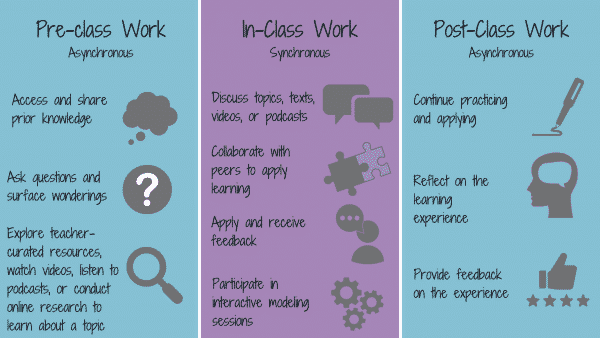
Tips from Teachers (curated from Jennifer Gonzalez of Cult of Pedagogy)
- Make the face-to-face time special–Try not to use this time to give all your tests or “cram” in all the content you plan to deliver. Use it build relationships and interact with each other.
- Putting direct instruction on video prevents you from having to repeat yourself over and over and allows students to watch at their own pace
- Chunk the time–As we move to the block schedule on top of the hybrid set-up it is helpful think of your time in various segments. You can select one of the models above to guide you. If you desire to have the at-home cohort log-on to your synchronous class time you might consider some of these models. They were shared by Beth Alexander, the Director of Teaching and Learning at a school in Toronto.
- Build community–This is always important and still is as teachers and students face this new classroom set-up.
Teachers can continue to use Canvas and other tech tools to manage and organize their courses. Reach out to a Tech Integration Specialist if you want a thought partner in this process. Submit a tech ticket and select the “Tech Integration” option.
If you are looking for more ideas, check out this collection of resources: https://wke.lt/w/s/N62hdh
Highlights from the February Google for Education Newsletter
Issue 36 was just released today. Below are some of its notices for your consideration.
Be Internet Awesome presents Safer Internet Day 2021
Join Be Internet Awesome on @googleforedu Twitter and Facebook for the 7-Day Internet Safety Challenge – promoting online safety all week long. We’ll share four new activities and tools for educators to use with their students.
Code.org celebrates Black Voices in Computer Science
Although computer science is foundational to every industry and field of study, representation and participation in CS is still far from balanced. Watch and share this inspiring video from our partner Code.org, advocating for greater access to CS education for Black students.
Arts & Culture: Blob Opera
From Google Arts & Culture’s Lab and artist David Li comes Blob Opera. Exploring the original musical instrument: our voice. Play four opera voices in real time. Explore pitch then record and share your musical composition. No singing skills required.
Arts & Culture: Preserving Egypt’s Layered History
Brings to life the archaeological discoveries, the archaeologists and preservation processes. With stories, 3D and AR models, Quizzes, videos, virtual tours and Choose Your Own Adventures, the project brings the treasures of Egypt into the classroom.
Wakelet & Google for Education: Showcase Challenge
Get involved in the Wakelet & Google for Education: Showcase Challenge! Share your ideas for making the most of Google for Education tools and showcase your expertise inside a Wakelet collection to get your hands on our exclusive digital swag pack.
Missed an issue of the Google for Education newsletter? Check out past issues here.
Did a friend or colleague forward you this email?
Sign up to get Google for Education updates in your inbox.
RESA Virtual Maker Summit
On March 25, Wayne RESA will be hosting a FREE virtual Maker-STEM Summit for educators. Author/illustrator Kevin O’Malley will be the keynote speaker followed by three breakout sessions. To learn more or to sign up, go here: https://www.smore.com/zc3wn
SCECHs will be available.
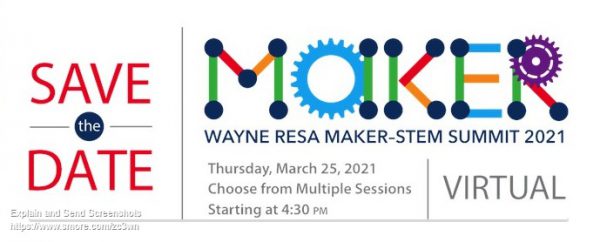
Black History Month Resources
February is Black History Month. Wayne RESA has put together several resources that teachers can use this month and throughout the school year to help infuse Black History in the curriculum.
Additionally, Flipgrid has curated several topics for students to engage with on their platform.
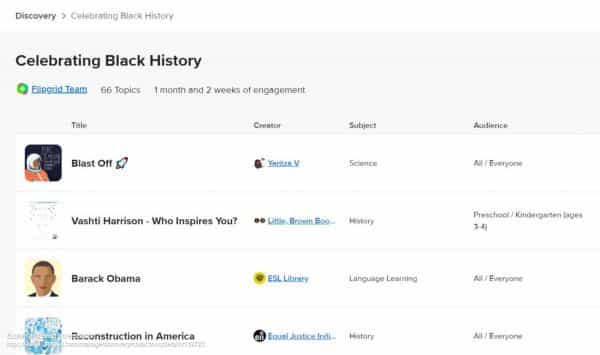
Wide Open School by Common Sense has linked several Black History and Culture lessons organized by grade, Preschool-12th grade. Google for Education has also released several new lessons in their Applied Digital Skills curriculum.
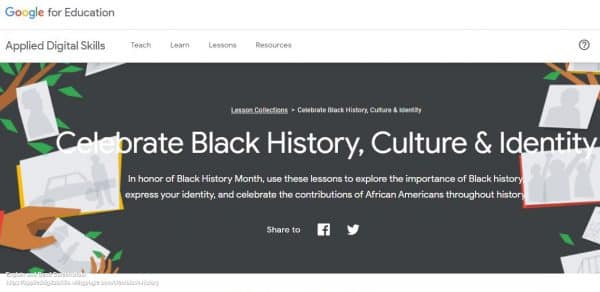
BrainPop’s February Teachers Lounge
BrainPop’s February newsletter for K-12 instructional staff can be found HERE.
As a reminder, all district students, K-12 can access our paid subscription to BrainPop/BrainPop Jr via Clever at https://clever.com/in/pccs
Pics below show some of what’s in their latest newsletter.
Tips for the Secondary Hybrid Schedule
Now that P-CCS is bringing middle school and high school students back on-campus, teachers may wish to further adjust their instruction for optimized learning with the new schedule. The hybrid schedule feels very unique to the times we are living in. Fortunately, schools across the country have been using it and teachers have insights to share. For this post, I have borrowed mostly from the work of Jennifer Gonzalez (Cult of Pedagogy) and Catlin Tucker, an experienced, blended learning coach. Consider reading the original posts for more information.
Four Models:
- Station Rotation: Think of your week or class period in 3 kinds of “stations” for students to rotate through: teacher-led, online activity, and an offline activity. Here’s a great template from Stephanie DeMichele. Here’s a link to some specific ideas for core content areas.
- Flipped Learning: Move the act of talking at students to asynchronous video so it can be more accessible for all (pause, re-watch, captions). Think of your week or class period in terms of a pre-video activity, during-the-video activity, and a post-video activity. If you desire, save time, by recording snippets of intended instruction during your live class to post in Canvas, directions here.
- Playlist Model: Playlists allow students to move through a sequence of learning activities. The playlist can build in choice as far as what modality and what combination of activities students choose. This model is also very similar to a hyperdoc which guides students through a complete lesson flow. In this model, teachers design the lesson in-advance and then spend time in class connecting with individuals and small groups to answer questions, clear misconceptions, and provide feedback.
- Pre/In/Post Class: This model simply helps you think about planning in terms of synchronous and asynchronous. Utilize Sections in Canvas to divide your class into cohorts so that each one sees their work at the appropriate time. See the graphic below from Catlin Tucker’s blog.

Tips from Teachers (curated from Jennifer Gonzalez of Cult of Pedagogy)
- Make the face-to-face time special–Try not to use this time to give all your tests or “cram” in all the content you plan to deliver. Use it build relationships and interact with each other.
- Putting direct instruction on video prevents you from having to repeat yourself over and over and allows students to watch at their own pace
- Chunk the time–As we move to the block schedule on top of the hybrid set-up it is helpful think of your time in various segments. You can select one of the models above to guide you. If you desire to have the at-home cohort log-on to your synchronous class time you might consider some of these models. They were shared by Beth Alexander, the Director of Teaching and Learning at a school in Toronto.
- Build community–This is always important and still is as teachers and students face this new classroom set-up.
Teachers can continue to use Canvas and other tech tools to manage and organize their courses. Reach out to a Tech Integration Specialist if you want a thought partner in this process. Submit a tech ticket and select the “Tech Integration” option.
If you are looking for more ideas, check out this collection of resources: https://wke.lt/w/s/N62hdh

